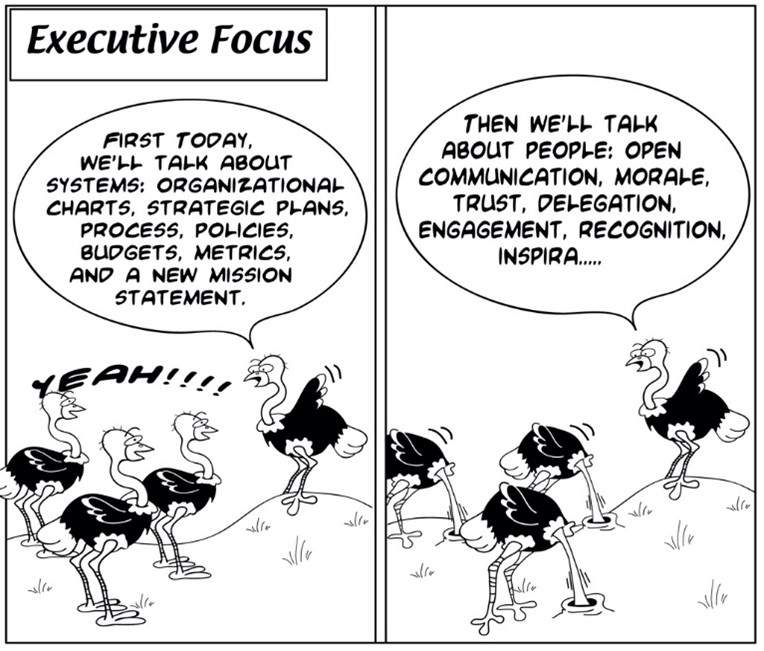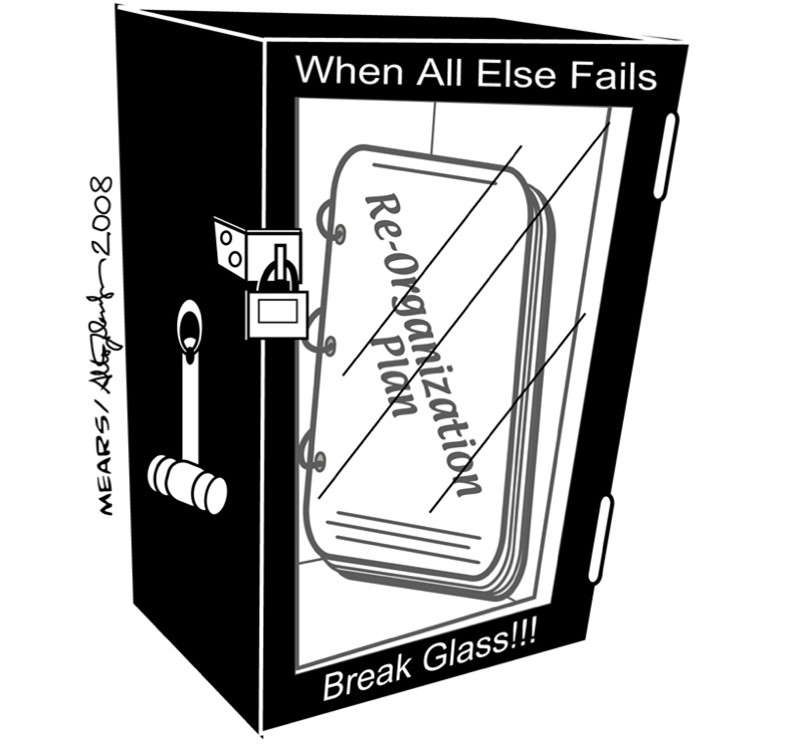Why do They Keep Reorganizing?
When I plopped down in the coffee shop booth, my friend tried to hide the document. He shuffled pages and pushed them aside.
Luckily, my days as a spy made it easy to read his memo upside down. That first sentence was a doozy—it contained two lies.
“This is not a major reorganization, and it will not impact you.”
From my upside-down view, I relished the title, Evolving Organizationally.
As we chatted, I discovered his boss’s reason behind the reorganization was to “reduce the number of people directly reporting to me to free up time to think strategically.”
My heart raced. For decades, I had collected reasons executives give to justify reorganizing—I had never heard “to free up time to think strategically.” I was excited, like an entomologist discovering a new bug.
You’ve seen this movie before
You know the pattern.
A new executive arrives and wants “greater collaboration.” They create a new vision statement, give speeches, launch a contest to create a new logo, and harangue direct reports to push for a new culture. They tinker with the organization chart, and a maelstrom erupts.
Like storms on the ocean’s surface, they unleash a thunderous communication plan. It has logical memos and notes discussing the need for change, one PowerPoint presentation after another, and placards and banners all over the place. On top of that are bully pulpit diatribes, threats of burning platforms, and a website containing everything any human would ever want to know about the need for the change.
No matter how many times the executive says, “It will not impact you,” employees sit on the ocean floor frozen in fear. It appears calm because their stress is hidden, but they obsess over career progression, who they will report to, and—if they still have a job—what they will be doing. Performance drops.
Other than that, not much changes. Employees are a bit more paranoid after the reorganizational bruising, but the culture, for good or bad, remains untouched.
After two years, the tempest blows over, the executive moves on, and a new executive with a different vision arrives to start the process all over again.
The reason reorganizations often flop is that we humans are not logical like Mr. Spock in the old Star Trek TV series. We’re emotional animals who don’t respond well to perfectly constructed executive arguments spelling out a need for change.
Change almost always agitates us—unless it’s our idea, of course.
Why do executives reorganize?
So why do executives consistently reorganize, transform, and restructure?
I asked the most astute observers of human behavior I know: CIA operational psychologists and FBI psychological profilers. Below are the fifteen intriguing answers I got from them.
Executives reorganize because:
- they can’t think of anything else to do
- it demonstrates they’re doing something
- they can see the reorganization on a chart
- it’s visible to stakeholders and the board of directors
- it’s easy
- it’s measurable
- they think they know what’s best
- they want to remove managers they don’t like
- it’s fast
- it can be likened to a dog marking a fire hydrant
- it gives them an immediate sense of accomplishment
- they’re egomaniacs
- they’re in control now—what could go wrong?
- it’s all they know
- they can
I delight in their answers, and although everything on the list could be true, another reason could be that executives aren’t sure how to deal with people problems or soft issues.
Let’s say Group A ignores Group B’s needs. Failing to collaborate is a soft issue—the executive stirs the pot and reorganizes both groups to “fix” the issue.
Maybe soft issues are too difficult
Soft issues are almost always more complicated, more intractable, and less visible because they involve people and their emotions, whereas hard issues, such as faulty plans and weak metrics, are a bit more straightforward and easier to solve.

When Group A fails to deliver a needed document to Group B, it sets off an alarm. The executive logically adds a new step in the process or institutes periodic reviews.
But perhaps the failure reflects a soft problem—it might involve an uncooperative culture festering below the surface.
When ignored, soft issues can become dangerous.
The ultimate soft issue—unhealthy organizational culture—significantly affects many companies.
What to do?
The solution to soft problems is not a reorganization plan. Try everything else first, as this cartoon shows.

Diagnose to see if it’s a human issue—is there a deficiency in any of the five Cs below?
- communication
- cooperation
- collaboration
- coordination
- culture
To solve these five issues, consider:
- the criteria and validity of how you select frontline managers,
- your management development process,
- day-to-day executive behaviors, and
- how employees are treated.
That last bullet point, “how employees are treated,” sounds mushy, but as human beings, we all want to be listened to, have a piece of the pie, engage in meaningful work, and have clarity on how we are doing, and get a little respect. That’s what makes people tick.
When you stop pushing against human nature, you won’t have as many problems.
Just don't break the glass
Whatever you do, don’t break the glass and pull out that reorganization plan.
Why?
Because in the face of soft problems, whether you read the reorganization plan right-side up or upside down like I did, it still won’t make any sense.
About the Author
Copyright © 2022 by Mike Mears, all rights reserved. Reproduced by permission.








